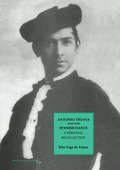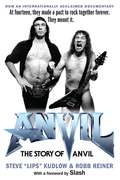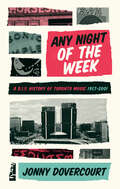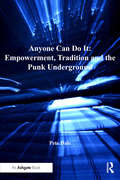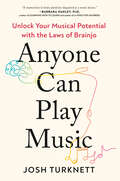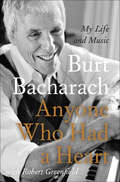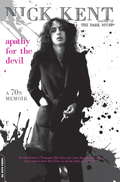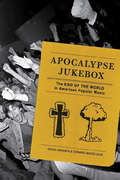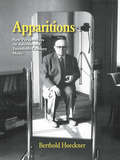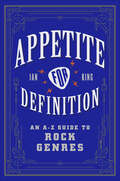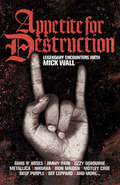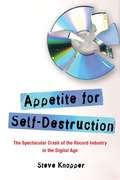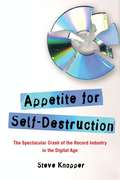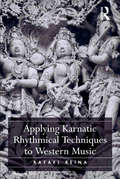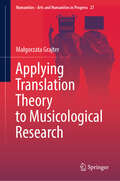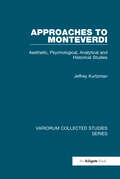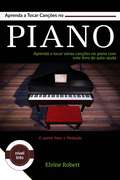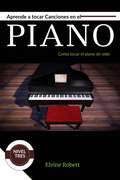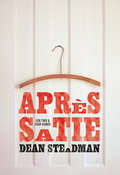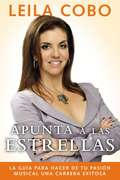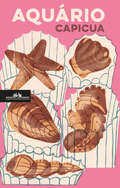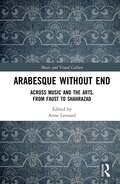- Table View
- List View
Antonio Triana and the Spanish Dance: A Personal Recollection (Choreography and Dance Studies Series #Vol. 6)
by Rita Vega de TrianaThis book also traces the evolution of the Spanish Dance technique, marked as it is by a turbulent history. Antonio Triana was a dancer of mature artistry, dignity and power. His physical and technical achievements went beyond what is generally known about Spanish Dance. His dance presented the essence of the Spanish character and, in his choreography, he used his traditional background for his brilliant inspirations. He partnered the legendary La Argentinita, Pilar Lopez and Carmen Amaya with spirit and gallantry. Over the years he developed a very distinct method of teaching and he became one of the foremost Spanish Flamenco dancers and teachers of his time. Rita Vega de Triana formed the Triana Ballet Español with her late husband. She currently teaches Hispanic dance and related subjects at the University of Texas at El Paso and directs her own school as well as performing around the United States as a guest artist and choreographer.
Anvil!
by Robb Reiner Lips ReinerIn the early seventies, when Led Zeppelin and Black Sabbath ruled the world, Steve "Lips" Kudlow and Robb Reiner, two young Jewish boys from the northern suburbs of Toronto, vowed to rock together forever. A decade later, their band Anvil released one of the heaviest records in music history, Metal on Metal, which influenced a whole musical generation, including the world-dominating bands Metallica, Slayer, and Anthrax. Yet while these bands went on to sell millions of records, Anvil slipped straight into obscurity. Was it too much sex and drugs and not enough rock 'n' roll? Was it the menagerie of pets that accompanied them on tour? Was it Lips's penchant for using a dildo to play his guitar (with integrity) and writing political songs like "Show Us Your T***"? Or was it their uncanny knack for setting themselves on fi re whenever a record company executive was watching? Now, almost thirty years later, like a real-life Spinal Tap, these unlikely musical heroes are still rocking, and still chasing their dream. Written in their own words, Anvil!: The Story of Anvil charts the rise, fall, and eventual triumph of two men whose indestructible friendship, talent, and determination took them on a unique journey in the world of rock. A bittersweet and frequently hilarious hymn to the human spirit, played loud in power chords, it is a story of true brotherly love, being a lifer, living the dream, and never giving up.
Any Night of the Week: A D.I.Y. History of Toronto Music, 1957-2001
by Jonny DovercourtThe story of how Toronto became a music mecca. From Yonge Street to Yorkville to Queen West to College, the neighbourhoods that housed Toronto’s music scenes. Featuring Syrinx, Rough Trade, Martha and the Muffins, Fifth Column, Shadowy Men on a Shadowy Planet, Rheostatics, Ghetto Concept, LAL, Broken Social Scene, and more! “Jonny Dovercourt, a tireless force in Toronto’s music scene, offers the widest-ranging view out there on how an Anglo-Saxon backwater terrified of people going to bars on Sundays transforms itself into a multicultural metropolis that raises up more than its share of beloved artists, from indie to hip-hop to the unclassifiable. His unique approach is to zoom in on the rooms where it’s happened – the live venues that come and too frequently go – as well as on the people who’ve devoted their lives and labours to collective creativity in a city that sometimes seems like it’d rather stick to banking. For locals, fans, and urban arts denizens anywhere, the essential Any Night of the Week is full of inspiration, discoveries, and cautionary tales.” —Carl Wilson, Slate music critic and author of Let’s Talk About Love: A Journey to the End of Taste, one of Billboard’s ‘100 Greatest Music Books of All Time’ “Toronto has long been one of North America’s great music cities, but hasn’t got the same credit as L.A., Memphis, Nashville, and others. This book will go a long way towards proving Toronto’s place in the music universe.” —Alan Cross, host, the Ongoing History of New Music “The sweaty, thunderous exhilaration of being in a packed club, in collective thrall to a killer band, extends across generations, platforms, and genre preferences. With this essential book, Jonny has created something that's not just a time capsule, but a time machine.” —Sarah Liss, author of Army of Lovers
Anyone Can Do It: Empowerment Tradition And The Punk Underground (Ashgate Popular and Folk Music Series)
by Pete DaleFor more than three decades, a punk underground has repeatedly insisted that 'anyone can do it'. This underground punk movement has evolved via several micro-traditions, each offering distinct and novel presentations of what punk is, isn't, or should be. Underlying all these punk micro-traditions is a politics of empowerment that claims to be anarchistic in character, in the sense that it is contingent upon a spontaneous will to liberty (anyone can do it - in theory). How valid, though, is punk's faith in anarchistic empowerment? Exploring theories from Derrida and Marx, Anyone Can Do It: Empowerment, Tradition and the Punk Underground examines the cultural history and politics of punk. In its political resistance, punk bears an ideological relationship to the folk movement, but punk's faith in novelty and spontaneous liberty distinguish it from folk: where punk's traditions, from the 1970s onwards, have tended to search for an anarchistic 'new-sense', folk singers have more often been socialist/Marxist traditionalists, especially during the 1950s and 60s. Detailed case studies show the continuities and differences between four micro-traditions of punk: anarcho-punk, cutie/'C86', riot grrrl and math rock, thus surveying UK and US punk-related scenes of the 1980s, 1990s and beyond.
Anyone Can Play Music: Unlock Your Musical Potential with the Laws of Brainjo
by Josh TurknettA neuroscience-based approach to learning how to play music at any ageYou can learn to play music, no matter what you've been told about your musical talent or aptitude. Each and every one of us has been gifted with a fully customizable brain, one we can mold to learn anything, at any age. With the right instruction and methods, learning to play music can be an endless source of joy and fulfillment. And learning to play music isn't just fun, it's also the ideal brain fitness activity. Dr. Turknett, a neurologist, self-taught multi-instrumentalist, and the founder of Brainjo and the Brainjo Method of instruction, which has been used successfully by thousands of people, distills the principles of learning to play music down into a set of universal "laws" that can be applied to any instrument. His innovative and proven approach synthesizes the latest in neuroscience and skill-building theory, emphasizing practicing smarter, not harder, recognizing that there is no failure, only feedback, and leveraging the immense power of subconscious learning. Success or failure in learning to play music, just like anything else, is driven by how we learn. More specifically, it is driven by how well we engage our brain's remarkable ability to change itself. Anyone Can Play Music is about the fundamental principles of learning, an owner's manual for molding a musical mind.The benefits of learning an instrument extend beyond the immense pleasure that it brings. Recent research indicates that stimulating neuroplasticity, or the brain&’s ability to change itself, leads to brain growth, reverses brain aging and even restores youthful brain function. The more areas of the brain that are stimulated, the greater the benefit. And when it comes to a whole brain workout, nothing beats playing music.While much of Dr. Turknett's detailed instructions are music-specific, the strategies underpinning this book apply not only to learning to play music, but to any kind of skill building. Our plastic brains are capable of so much more than we realize, as long as we can learn how to learn.
Anyone Who Had a Heart: My Life and Music
by Robert Greenfield Burt BacharachOne of the greatest songwriters of all time finally shares his story in this “absorbing” autobiography (Rolling Stone).From his tumultuous marriages and the tragic loss of his daughter to his collaborations with Dionne Warwick and the surprising stories behind the songs that generations have come to know and love, Burt Bacharach offers a frank, moving account of an unparalleled life.Over six decades, Burt Bacharach’s legendary songwriting touched millions of devoted listeners all over the world. In Anyone Who Had a Heart, Bacharach steps out from behind the music to give an honest, engaging look at his life—from his childhood in Forest Hills, New York, during the 1930s and 1940s to his rise as one of the most accomplished composers in modern popular music, working with Hal David, Dionne Warwick, Elvis Costello, and many others.While he soared professionally, Bacharach’s private life was dominated by the never-ending search for love—and the heartbreak that comes when it is lost. His first three marriages ended in divorce. His long-running partnership with the late Hal David suffered a bitter split that lasted seventeen years. Throughout the highs and lows, Bacharach pursued his muse. Powerful and honest, Anyone Who Had a Heart illuminates the sensitivity and intelligence of a musical legend and offers a unique backstage look at the world of show business.“A congenial overview of a life devoted to music. . . . Illuminating and gritty.”—Kirkus Reviews
Apathy for the Devil: A Seventies Memoir
by Nick KentChronicling Nick Kent’s up-close , personal, often harrowing adventures with the Rolling Stones, Lester Bangs, David Bowie, Led Zeppelin, the Sex Pistols, and Chrissie Hynde, among scores of others,Apathy for the Devilis a picaresque memoir that bears witness to the beautiful and the damned of this turbulent decade. As a college dropout barely out of his teens, Kent’s first five interviews were with the MC5, Captain Beefheart, the Grateful Dead, the Stooges, and Lou Reed. But after the excitement and freedom of those early years, his story would come to mirror that of the decade itself, as he slipped into excess and ever-worsening heroin use. Apathy for the Devilis a compelling story of inspiration, success, burn out, and rebirth from a classic wordsmith.
Apocalypse Jukebox: The End of the World in American Popular Music
by Edward Whitelock David JanssenFrom its indefinite beginnings through its broad commercialization and endless reinterpretation, American rock-and-roll music has been preoccupied with an end-of-the-world mentality that extends through the whole of American popular music. In Apocalypse Jukebox, Edward Whitelock and David Janssen trace these connections through American music genres, uncovering a mix of paranoia and hope that characterizes so much of the nation’s history.From the book’s opening scene, set in the American South during a terrifying 1833 meteor shower, the sense of doom is both palpable and inescapable; a deep foreboding that shadows every subsequent development in American popular music and, as Whitelock and Janssen contend, stands as a key to understanding and explicating America itself.Whitelock and Janssen examine the diversity of apocalyptic influences within North American recorded music, focusing in particular upon a number of influential performers, including Bob Dylan, Leonard Cohen, John Coltrane, Devo, R.E.M., Sleater-Kinney, and Green Day. In Apocalypse Jukebox, Whitelock and Janssen reveal apocalypse as a permanent and central part of the American character while establishing rock-and-roll as a true reflection of that character.
Apparitions: Essays on Adorno and Twentieth-Century Music
by Berthold HoecknerApparitions takes a new look at the critical legacy of one of the 20th century's most important and influential thinkers about music, Theodor W. Adorno. Bringing together an international group of scholars, the book offers new historical and critical insights into Adorno's theories of music and how these theories, in turn, have affected the study of contemporary art music, popular music, and jazz.
Appavin Snehidar (My Father's Friend and Other Stories)
by Lakshmi Holmström AshokamitranMy Father's Friend and Other Stories. English translation by Lakshmi Holmström of the Sahitya Akademi Award-winning Tamil short story collection of Ashokamitran's Appavin Snehidar.
Appetite for Definition: An A-Z Guide to Rock Genres
by Ian King“King brings an informative voice that will enlighten all fans of rock music in its many permutations. This encyclopedia of rock is sure to spark many heated conversations.” — Publishers Weekly“Recommended to all interested in the history of rock music, those looking for new music recommendations, and anyone who wants to improve their rock and roll vocabulary.” — Library Journal“Works as casual reading, a handy reference tool, inspiration for listeners stuck in a musical rut, and a welcome addition to library music collections.” — Booklist
Appetite for Destruction: The Mick Wall Interviews
by Mick WallWhether it's hanging around with Marillion's Fish in Berlin, seeing Whitesnake fail to ignite 1985's Rock in Rio, talking through old times with Jimmy Page in his Berkshire pile or following Ozzy Osbourne to Moscow, there isn't a rock luminary that Wall hasn't cross-examined or kept the flame burning with at some point over the last thirty years. Here, amongst several pieces, he catches Lars Ullrich just on the cusp of world domination; has dinner with Ritchie Blackmore on the eve of a Deep Purple comeback; and is up all night in LA with W. Axl Rose.APPETITE FOR DESTRUCTION gathers together Wall's journalism for Kerrang!, for whom he was the star writer in their eighties heyday. It also features brand-new introductions to all the pieces, written with maybe less hair but also the benefit of twenty years' hindsight.
Appetite for Destruction: The Mick Wall Interviews
by Mick Wall'APPETITE FOR DESTRUCTION has the best of Wall's Kerrang! features, each bolstered by new, insightful post-scripts. You won't read a funnier rock book****' MOJO'Wall is firing on all cylinders' CLASSIC ROCK'This hilarious tome is a collection of his finest moments... Wall had a great knack from getting under the skin of interviewees' BIG ISSUEWhether it's hanging around with Marillion's Fish in Berlin, seeing Whitesnake fail to ignite 1985's Rock in Rio, talking through old times with Jimmy Page in his Berkshire pile or following Ozzy Osbourne to Moscow, there isn't a rock luminary that Wall hasn't cross-examined or kept the flame burning with at some point over the last thirty years. Here, amongst several pieces, he catches Lars Ullrich just on the cusp of world domination; has dinner with Ritchie Blackmore on the eve of a Deep Purple comeback; and is up all night in LA with W. Axl Rose.APPETITE FOR DESTRUCTION gathers together Wall's journalism for Kerrang!, for whom he was the star writer in their eighties heyday. It also features brand-new introductions to all the pieces, written with maybe less hair but also the benefit of twenty years' hindsight.
Appetite for Self-Destruction: The Spectacular Crash of the Record Industry in the Digital Age
by Steve KnopperFor the first time, Appetite for Self-Destruction recounts the epic story of the precipitous rise and fall of the recording industry over the past three decades, when the incredible success of the CD turned the music business into one of the most glamorous, high-profile industries in the world -- and the advent of file sharing brought it to its knees. In a comprehensive, fast-paced account full of larger-than-life personalities, Rolling Stone contributing editor Steve Knopper shows that, after the incredible wealth and excess of the '80s and '90s, Sony, Warner, and the other big players brought about their own downfall through years of denial and bad decisions in the face of dramatic advances in technology. Big Music has been asleep at the wheel ever since Napster revolutionized the way music was distributed in the 1990s. Now, because powerful people like Doug Morris and Tommy Mottola failed to recognize the incredible potential of file-sharing technology, the labels are in danger of becoming completely obsolete. Knopper, who has been writing about the industry for more than ten years, has unparalleled access to those intimately involved in the music world's highs and lows. Based on interviews with more than two hundred music industry sources -- from Warner Music chairman Edgar Bronfman Jr. to renegade Napster creator Shawn Fanning -- Knopper is the first to offer such a detailed and sweeping contemporary history of the industry's wild ride through the past three decades. From the birth of the compact disc, through the explosion of CD sales in the '80s and '90s, the emergence of Napster, and the secret talks that led to iTunes, to the current collapse of the industry as CD sales plummet, Knopper takes us inside the boardrooms, recording studios, private estates, garage computer labs, company jets, corporate infighting, and secret deals of the big names and behind-the-scenes players who made it all happen. With unforgettable portraits of the music world's mighty and formerly mighty; detailed accounts of both brilliant and stupid ideas brought to fruition or left on the cutting-room floor; the dish on backroom schemes, negotiations, and brawls; and several previously unreported stories, Appetite for Self-Destruction is a riveting, informative, and highly entertaining read. It offers a broad perspective on the current state of Big Music, how it got into these dire straits, and where it's going from here -- and a cautionary tale for the digital age.
Appetite for Self-Destruction: The Spectacular Crash of the Record Industry in the Digital Age
by Steve KnopperFor the first time, Appetite for Self-Destruction recounts the epic story of the precipitous rise and fall of the recording industry over the past three decades, when the incredible success of the CD turned the music business into one of the most glamorous, high-profile industries in the world -- and the advent of file sharing brought it to its knees. In a comprehensive, fast-paced account full of larger-than-life personalities, Rolling Stone contributing editor Steve Knopper shows that, after the incredible wealth and excess of the '80s and '90s, Sony, Warner, and the other big players brought about their own downfall through years of denial and bad decisions in the face of dramatic advances in technology.
Applying Karnatic Rhythmical Techniques to Western Music
by Rafael ReinaMost classical musicians, whether in orchestral or ensemble situations, will have to face a piece by composers such as Ligeti, Messiaen, Varèse or Xenakis, while improvisers face music influenced by Dave Holland, Steve Coleman, Aka Moon, Weather Report, Irakere or elements from the Balkans, India, Africa or Cuba. Rafael Reina argues that today’s music demands a new approach to rhythmical training, a training that will provide musicians with the necessary tools to face, with accuracy, more varied and complex rhythmical concepts, while keeping the emotional content. Reina uses the architecture of the South Indian Karnatic rhythmical system to enhance and radically change the teaching of rhythmical solfege at a higher education level and demonstrates how this learning can influence the creation and interpretation of complex contemporary classical and jazz music. The book is designed for classical and jazz performers as well as creators, be they composers or improvisers, and is a clear and complete guide that will enable future solfege teachers and students to use these techniques and their methodology to greatly improve their rhythmical skills. An accompanying website of audio examples helps to explain each technique. For examples of composed and improvised pieces by students who have studied this book, as well as concerts by highly acclaimed karnatic musicians, please copy this link to your browser: http://www.contemporary-music-through-non-western-techniques.com/pages/1587-video-recordings
Applying Translation Theory to Musicological Research (Numanities - Arts and Humanities in Progress #27)
by Małgorzata GrajterThis monograph lays the foundation for new methodologies of research between music and translation. It is the first such holistic attempt—from the perspective of a musicologist—based on the adaptation of translation theories. Until now, these fields have remained underexplored together. Only recently have the tools developed by translation theory permeated into musical scholarship. Such tools should prove as a promising alternative to those offered by classic musicological studies, particularly in reference to musical arrangement, pop music covers and performance. Theoretical discussion on topics are supported by case studies. This text appeals to musicologists and musicians as well as experts in the field of translation theory who are interested in expanding their field of inquiry.
Approaches to Monteverdi: Aesthetic, Psychological, Analytical and Historical Studies (Variorum Collected Studies)
by Jeffrey KurtzmanThis volume gathers together twelve essays on the composer’s music, reflecting the author's interests in aesthetic and psychological issues, the sacred works, methods of structural analysis, and the problems of making critical editions. The opera Orfeo and two madrigals from Monteverdi's Book Eight are the subject of aesthetic and psychological investigation, especially from the perspective of Michel Foucault's The Order of Things and the psychology of C.J. Jung, all supported by musical analysis. Two essays analyze in detail the structural principles of the psalms Laetatus sum from the 1610 Vespers and the first Dixit Dominus from the Sevla Morale e spirituale of 1641. Two others re-examine the story of Monteverdi's Mass of Thanksgiving and consider the question of what sacred music Monteverdi actually or likely wrote but is now lost. The final essay critiques and compares the methodology and problems of the Malipiero and Cremona editions of Monteverdi's Opera Omnia. All but one of these essays were originally published over a time span of twenty years in journals, conference reports, Festschriften, and as book chapters. The majority of them were not widely distributed or readily available until now. The essay on the Malipiero and Cremona editions appears here for the first time.
Aprenda a Tocar Canções no Piano: Aprenda a tocar várias canções no piano com este livro de auto-ajuda (O portal Para a Perfeição #3)
by Elvine RobertOlá! Você está cansado de não ser capaz de tocar piano como sempre imaginou? Você tem conhecimento em teoria de piano mas ainda não sabe como aplicar esse conhecimento para a sua execução de piano de forma prática? Então este livro é para você! Neste livro; Aprenda a tocar canções no Piano, Nós vamos observar: • Alterações de acordes. • Como melodias são harmonizadas usando acordes simples e avançados. • Como tocar várias canções de ouvido. Canções que nós vamos observar incluem: • Amazing Grace • Pass me not • O come, let us adore Him • Silent Night • Don't know why e muito mais! Este livro vai marcar o fim da série "O Portal para a Perfeição." NÃO PERCA ESSA GRANDE OPORTUNIDADE E CONSIGA SUA CÓPIA AGORA SOBRE TOCAR O PIANO! Para conseguir uma cópia, deslize para cima e clique no botão COMPRAR ou ADICIONAR AO CARRINHO
Aprende a tocar canciones en el piano
by Elvine Robert¡Hey tú! ¿Estás cansado de no poder tocar el piano como siempre lo has deseado? ¿Tienes conocimientos de técnica pianística pero no sabes cómo aplicarlo correctamente? ¡Entonces este libro es para ti! En este libro: Aprender a tocar Canciones en el Piano, veremos: •Acordes Alterados. •Como armonizar las melodías usando ambos acordes, simples y avanzados. •Como tocar varias canciones de oído. Algunas de las canciones que veremos son: •Amazing Grace •Pass me not •O come, let us adore Him •Silent Night •Don't know why •Y algunas mas. Este libro sería el final de la serie "El Camino a la Perfección". !NO PIERDAS ESTA GRANDIOSA OPORTUNIDAD Y OBTEN AHORA MISMO TU COPIANO EN PLAYING THE PIANO¡ DON'T MISS THIS GREAT OPPORTUNITY AND GET YOUR COPY NOW ON PLAYING THE PIANO! Para obtener tu copia, ve al inicio de la página y da click en el botón de COMPRAR o AGREGAR AL CARRO.
Après Satie: For Two and Four Hands
by Dean SteadmanA man who might be Erik Satie floats, a la Magritte, above Paris rooftops, thinking of a newly-extinct species of songbirds, "contemplating grief in the absence of song." By turns tender, wry, playful and fierce, the poems in Dean Steadman’s second collection, Apres Satie -- For Two and Four Hands, use surreal imagery, recurring characters and cyclical themes to evoke the repetitive nature of much of Satie’s music, as well as the artistic and intellectual temperament of Paris during Satie's most creative years. The prose poems in the collection borrow titles from Satie's piano compositions, and all of the poems are annotated in a manner similar to Satie's published scores, using a selection of his performance instructions (for example, "like a nightingale with a toothache"). From the affair of Satie and painter Suzanne Valadon to the glimpsed lives of a contortionist, a French cowboy, a Falling Man, and a Floating Woman in the Dada-inflected prose poems, to the musings in other poetic forms that draw us forward in time, to a present-day hospice, or back, to the gallop of a mounted huntress, Apres Satie involves us in the ongoing muddle of pain, sorrow, compassion, passion, joy and curiousness that is our human condition.
Apunta a las estrellas
by Leila CoboApunta a las estrellas es la guía esencial e imprescindible para todo el que quiera transformar sus sueños musicales en realidad ¿Tienes potencial y talento? ¡Buenísimo! ¿Pero sabías que el talento solo no te llevará al estrellato? Para alcanzar a las estrellas, primero tienes que saber dónde apuntar y cuáles son las herramientas que te ayudarán a transformar tu pasión en una gran carrera. Leila Cobo, una experta clave de la industria, es la persona ideal para ayudarte a descubrir el camino al éxito. Sus consejos, basados en su experiencia y conocimiento, se encuentran intercalados con anécdotas fascinantes que ha recopilado a través de los años entrevistando a las estrellas más importantes de la música latina. Con esta combinación única aprenderás que necesitas una dosis de suerte, mucha perseverancia y carisma, así como un buen mánager, canciones contagiosas, excelente promoción y mucho más para cumplir este gran sueño de la música. Apunta a las estrellas no sólo es una guía práctica y útil para comprender cómo funciona la industria musical, sino también es una fuente de inspiración con un sinfín de ejemplos de cómo lograr que tus sueños y metas se conviertan en realidad.
Aquário
by CapicuaAquário é uma moldura, um recorte ou, se quisermos, uma janela para os mares interiores de Capicua. Ora confessional, ora furiosa, mas sempre perspicaz, inconformada e inteligente, além de totalmente entregue à experiência da «matrescência», Capicua dá ao leitor uma caixa de bombons em forma de livro. Crónicas, pequenos textos, poemas e algumas letras, para rir, chorar e acenar com a cabeça em jeito de concordância - às vezes, surpreendidos por não termos reparado no mundo como Capicua faz. Aquário é uma moldura, um recorte ou, se quisermos, uma janela para os mares interiores de Ana Matos Fernandes. Palavras fluidas, que disparam rascunhos de canções, críticas sociais, rasgos de esperança, amor e desabafos.
Arabesque without End: Across Music and the Arts, from Faust to Shahrazad (Music and Visual Culture)
by Anne LeonardFeaturing multidisciplinary research by an international team of leading scholars, this volume addresses the contested aspects of arabesque while exploring its penchant for crossing artistic and cultural boundaries to create new forms. Enthusiastically imported from its Near Eastern sources by European artists, the freely flowing line known as arabesque is a recognizable motif across the arts of painting, music, dance, and literature. From the German Romantics to the Art Nouveau artists, and from Debussy’s compositions to the serpentine choreographies of Loïe Fuller, the chapters in this volume bring together cross-disciplinary perspectives to understand the arabesque across both art historical and musicological discourses.
Arban's Complete Conservatory Method for Trumpet (Dover Books on Music)
by Jb Arban"The trumpeter's bible" for over 150 years, this complete pedagogical method contains hundreds of exercises, beginning with basics and progressing to advanced compositions, including the author's famous arrangement of Carnival in Venice. J. B. Arban discusses every aspect of playing — including articulation, tonguing, slurs, tone, and range — sharing the knowledge he acquired from many years of experience as a teacher and performer. He offers an appreciation of all the instrument's inherent difficulties as well as instructive points that touch upon all possible musical questions.The Paris Conservatory's Committee on Music Study noted, "This work is rich in instructive advice, is based upon the best of fundamental principles, and omits not a single instructive point which might be needed for the development and gradual technical perfection of a player." This edition features an Introduction and expert commentary by an instructor well versed in the Arban Method.
